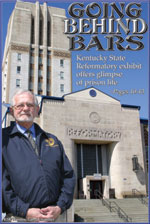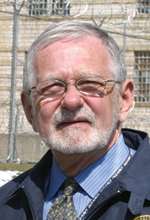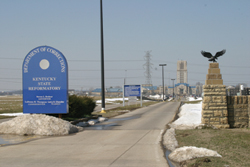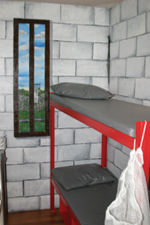



Going Behind Bars
Kentucky
State Reformatory
exhibit explores prison life
Landmark
institution influences
Oldham County’s landscape, culture
By
Helen E. McKinney
Contributing Writer
LA GRANGE, Ky. (April 2008) – A lot of people
drive by and do not realize what goes on here.”
 |
|
Apirl
2008 Kentucky |
Warden Larry Chandler is referring to the day-to-day life
at the Kentucky State Reformatory in Buckner, Ky., a life-changing experience
for all who enter the Gothic-styled structure.
Chandler is nearing retirement and has served as warden at the Reformatory
since 2003. He is originally from nearby Trimble County, where he began
his judicial career as a jailer and has been employed in various areas
of corrections over the years.
“The Reformatory is a huge part of the community,” said Chandler.
He is proud to be employed at so vital a part of the state’s correctional
system. The Reformatory’s legacy spans several centuries, and it
is this history that will carry it into the future, he says.
When Kentucky became a state in 1792, the penalty for all felonies was
death. Seven years later, a penitentiary was established on one acre
in Frankfort. That set the stage for the current Kentucky State Reformatory.
Changes have been made since then to the state’s correctional system,
many of which will be shown through a new exhibit at the Oldham County
History Center titled, “Serving Life: The Kentucky State Reformatory.”
The exhibit will run from March 15 through Aug. 15.
“It is good to get some positive publicity, and this exhibit should
help us do that,” Chandler said. “They came to us about doing
the exhibit; it wasn’t our idea, which I think shows a genuine
interest in the history of this place by the people of the area.”
Included in the exhibit will be a timeline, prison crafts, examples
of contraband, the effect of the consent decree laws of the early 1980s,
daily life of an inmate, prison industries, work of a correctional officer,
services and contributions to the county, and a typical size prison
cell constructed by inmates at the Reformatory.
There was very little information about the Reformatory in the History
Center archives, said Oldham County History Center Executive Director
Nancy Theiss. “It is another story, event and place that has impacted
our history and fulfills our mission to preserve, collect and convey
the history of Oldham County.”
 |
|
‘A
lot of |
Visitors will learn about the culture of prison life and
the social institution of corrections, social reform and democracy,
said Theiss. It is a facility “that has influenced the culture
of Oldham County from the numbers of people who have worked there, the
businesses that have been associated with the Kentucky State Reformatory
and the inmates who have passed through the prison system.”
Long before the current structure was built, the 1799 plans for the
Kentucky State Penitentiary called for 30 prisoners to be housed in
cells 6x8-feet in size and nine feet high. One year later, the first
prisoner, horse thief John Turner, arrived in Frankfort at what was
the first penitentiary built west of the Allegheny Mountains.
Inmates were not permitted to sit idly in cells all day long but used
their time constructively. By 1808, they were producing nails, log chains,
plow irons, axes, hoes, shoes, boots, and tin and copper ware. Between
1825 and 1834, prisoners were turning out chairs, shoes, wagons, sleighs
and weaving cloth.
Two thirds of the inmates were making rope from hemp by this time. From
1857 to 1859, hemp was the state’s largest cash crop.
Records of daily life in prison were kept. William C. Sneed, a penitentiary
physician from 1844 to 1863, published a history of the penitentiary
chronicling the years 1798 to 1860.
In the years directly following the Civil War, more than one-third of
the prisoners were between 15 and 20 years old. As the number of inmates
increased, problems such as overcrowding, fighting and rioting began
to surface.
Public opinion frequently conjured up a dark and dismal picture of the
state penitentiary. In 1873, the editor of the Louisville Courier-Journal
wrote that Kentucky was the only state where convicts were sold into
“absolute slavery.” This was derived from the idea of inmates
being leased out for hard labor to individuals or businesses with no
pay or personal benefit.
 |
|
Photo
by Don Ward The
entrance to the Reformatory on |
The Kentucky State Penitentiary at Frankfort in 1912 was
renamed the Kentucky State Reformatory. It wasn’t until 1936 that
Kentucky legislation appropriated funding for a 2,800-acre farm one
mile west of La Grange on the L&N Railroad as the first step toward
building a medium security institution. This facility would replace
the Frankfort penitentiary and was the third prison built in the Commonwealth
of Kentucky following the establishment of a penal system by the Kentucky
Legislature in 1798.
Matching funds from the Public Works Administration were awarded, and
the total cost of the project was $3 million. In March 1937, the National
Guard moved 30 inmates to the new site. Inmates lived in tents while
the barracks and stockade were built.
Assisted by the offices of the Grand Lodge of Masonic Order, then-Gov.
A.B. “Happy” Chandler dedicated the facility on Monday, Oct.
9, 1939. Two corner stones credit Chandler and his Commission, along
with the president of the United States, Franklin D. Roosevelt, for
making the Kentucky State Reformatory possible.
Architect William Strudwick Arrasmith designed the gothic-styled building.
He was best known for his art deco greyhound bus stations. “He
altered the design of the Kentucky State Reformatory tower from a building
that he designed for an architectural competition in Chicago in the
early 1930s,” said Theiss.
|
“Serving
Life”
• At
the Peyton Samuel Head Family Museum, located on the grounds of
the Oldham County Historical Society, 106 N. Second Ave., La Grange,
Ky. |
The Kentucky State Reformatory is a medium security facility
under the administration of the Kentucky Justice Cabinet, Department
of Corrections. In terms of inmate population, it is the state’s
second-largest institution with a 2005-bed capacity.
Originally, the prominent 12-story central tower was designed to house
the offices of key staff members, a hospital, medical offices and living
quarters for correctional staff. The 11th floor currently houses the
elevator machinery; the 12th floor houses a now defunct 150,000-gallon
water tank.
Other buildings on the 40-acre property include an academic-vocational
school, gymnasium, chapel, dining facility, inmate canteen, correctional
industries, visitation building and mental health building.
A staff of 600 employees oversees the Reformatory, the Roederer Farm
Complex (assessment center) and Luther Luckett Correctional Complex
(psychiatric center), which was built in direct response to the Federal
Consent Decree. The staff is responsible for maintaining an environment
that creates good behavior.
“We prepare inmates to go back into society,” said Chandler.
Many programs are offered to inmates at the Kentucky State Reformatory.
A wide range of programs is designed to assist inmates based upon their
needs and desire for self-help. These programs include a Pre-Release
Program, Alcoholics Anonymous, Books Behind Bars, NAACP and Veteran
Club.
 |
|
Photo
by Don Ward This
exhibit display of |
The Reformatory offers a large variety of programs from
which inmates can learn to better themselves, said Gary Prestigiacomo,
Unit Administrator II and Public Information Officer. “We expect
them to be involved in programs.”
An inmate’s life changes dramatically twice, Chandler said, “The
day they come in and the day they leave.”
Based upon this theory Chandler said, “We believe in education.”
He firmly believes that education has a positive impact on inmates.
This point is expressed in one of two DVDs produced by inmates for the
History Center exhibit. “A Day in the Life” and “Wearing
the Shield” give a glimpse of prison life to outsiders.
They are “realistic productions to display to the public,”
said Prestigiacomo, who supervised the filming. Three inmates were mainly
responsible for writing the script, filming and editing. They worked
through the Educational TV Department.
“A Day in the Life” features inmate Terry Williams and gives
a small glimpse of what goes on in prison. The film opens with Williams
writing a letter home to his mother from his single cell and follows
him through his typical daily routine, which he describes as “lonely”
at times.
Williams displays a brief sense of humor about it all by commenting,
“If there is any one thing that makes a man regret coming to prison,
it’s the food.”
“Wearing the Shield” depicts correction officers at work.
“They have the toughest job,” said Prestigiacomo, one officer
often supervising up to 210 inmates at one time.
Prestigiacomo has 622 inmates in his care, having worked at the Reformatory
since 1980. He said both films could be expanded upon in the future
and will be preserved.
“They are a fantastic opportunity to tell our story.”